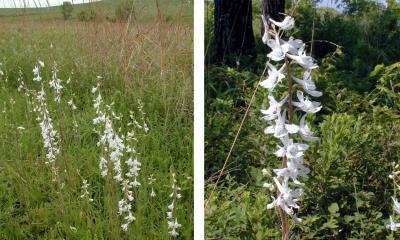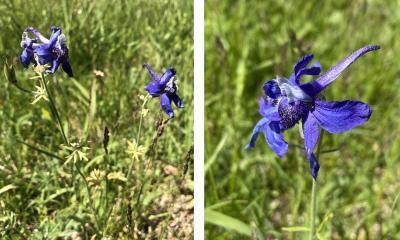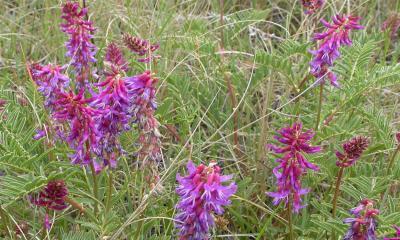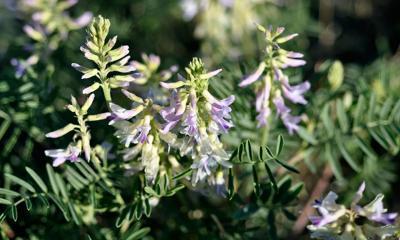By Jessalyn Bachler
In the second article of the Poisonous Plants on Rangelands series, larkspurs and poisonvetches will be discussed. Larkspurs are the second leading cause for all livestock deaths from toxic plant poisoning. Poisonvetches are considered accumulator plants that uptake excessive levels of selenium and cause toxicity problems in cattle.
Larkspurs

Figure 1. Prairie larkspur. Courtesy: Mike Haddock, kswildflower.org.
Larkspurs, specifically prairie larkspur and low larkspur, are characterized by having simple stems with slender, palmate leaves and raceme, flowering seed heads.
PRAIRIE LARKSPUR
Prairie larkspur (Figure 1) is commonly found across western South Dakota on short or mixed-grass prairies, and it is noted by its tall (up to three feet tall) white to pale pink inflorescence that is created by five sepals coming to an identifiable tubular spur found on all larkspurs.

Figure 2. Low Larkspur on a South Dakota rangeland. Note the tubular spur of the backside of the sepals. Courtesy: J. Bachler and K. Ehlert.
LOW LARKSPUR
Low larkspur is also found throughout western South Dakota, and it is notably abundant in the Black Hills region. Low larkspur is shorter (up to two feet tall) compared to prairie larkspur and has fewer leaves near the base of the plant; spurred, showy, blue-violet flowers with five sepals characterize the terminal raceme seed head (Figure 2).
Larkspurs are palatable to cattle and contain high levels of alkaloids, making them especially toxic. Because of this, larkspurs cause the second highest deaths in livestock from poisonous plants across the western United States. Five pounds of larkspur consumed within an hour is a lethal dose for a 1,000-pound cow. Nervousness, staggering, salivation, muscular twitching, bloat, respiratory paralysis and death are signs of larkspur poisoning. Other livestock species, such as sheep and horses, are less susceptible to larkspur poisoning. It is often recommended to graze sheep before cattle in larkspur-infested pastures to lower the risk of poisoning for cattle.
Poisonvetches

Figure 3. Twogrooved poisonvetch. Note the dense plant stand. Courtesy: Matt Lavin, Montana Field Guide, MT.GOV.
If excessive selenium is found in the soil, many plants will uptake and store the micronutrient in excess, causing extremely high levels (up to 3,000 ppm) that are toxic to livestock to be present when the plant is grazed. Certain species of milkvetches that accumulate toxic levels of selenium are referred to as poisonvetches. Two species of poisonvetches are found on South Dakota rangelands, twogrooved poisonvetch and creamy poisonvetch.
TWOGROOVED POISONVETCH
Twogrooved poisonvetch (or twogrooved locoweed) (Figure 3) is found in areas with soils that have high selenium concentrations, and it is scattered across eastern South Dakota. Twogrooved poisonvetch has a dense plant stand, spanning over two feet tall and wide; it has smooth, pinnate leaves and develops numerous rose-purple colored flowers on the raceme seed head in July through August. The plant is easily identifiable by the two grooves that run along the length of the pod and a strong scent of selenium, which smells like mouse urine.

Figure 4. Creamy poisonvetch. Courtesy: Mike Haddock, kswildflower.org.
CREAMY POISONVETCH
Creamy poisonvetch or racemed poisonvetch is more abundantly found across South Dakota in selenium-rich soils, especially along the Missouri River; it has a woody taproot with large, red-colored stems and green, pinnate leaves (Figure 4). The raceme seed head appears in late May to July with a dense set of white or yellowish flowers. Creamy poisonvetch, like twogrooved poisonvetch, also has a strong selenium odor.
Neither of the poisonvetches are considered palatable to livestock. However, they may contribute to selenium poisoning in livestock by making selenium available in the soil for neighboring plants to uptake and accumulate. Plants with moderate concentrations of selenium (less than 200 ppm) can cause selenium toxicity in cattle and can lead to two different syndromes: blind staggers and alkali disease. Blind staggers are exhibited when cattle have an unsteady gate and aimlessly wander and walk into unmovable objects; they also may be lethargic and easily excited. If selenium poisoning continues, cattle will eventually enter paralysis and die from respiratory failure. Alkali disease is a chronic condition that is associated with selenium toxicity where cattle become dull and emancipated and then lame due to overgrown hooves. If caught early, livestock can recover from selenium toxicity by removal from the poisonous plants.
Source : sdstate.edu